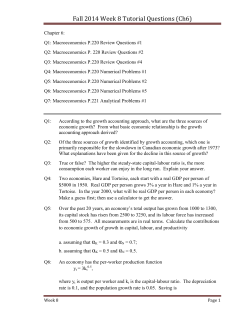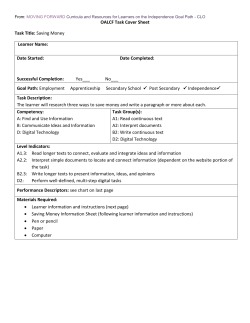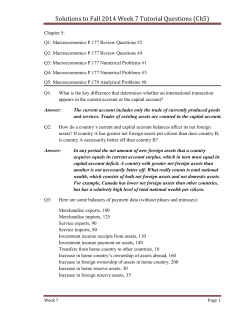
Answer Key for Sample Questions for Midterm 2010
Answer Key for Sample Questions for Midterm 2010 Part A: True or False Statements. Label each of the following statement true, false, or uncertain. Explain your answer. 1. In the long-run, increases of saving rate will only affect the level of output, but cannot sustain the growth rate of output. Answer: True/uncertain. If the production function satisfies the property of decreasing return to capital, as the one we discussed in Chapter 10 and 11, then increase in the saving rate will only lead to a higher growth rate of output per worker for some time, but not forever. In the long run capital accumulation will only affect the level of output per capita, but not the growth rate of output per capita. 2. Countries start with a lower capital per capita will grow at a faster growth rate, this is called convergence. Answer: False. As shown in class, only when two economies have the same saving rate, depreciation rate, and production function (and therefore have the same steady state), we can show that the economy which starts with a lower capital per capita will grow faster. But if two economies have different steady state, it is possible that rich country may grow faster than poor country. 3. When deciding how much investment to undertake, firms care about real interest rate. So when expected inflation increases, IS curve will shift to the left. Answer: False. It is true that when making decision about investment, firms care about real interest rates. This is because the return of investment is in terms of real goods, so when considering the cost of investment, firms care about real interest rates. However, the claim about the shift of IS curve is wrong. Part B: Short Answer Questions: 1. Consider a closed economy; list what (for example, policies, factors, etc) will lead to changes in output in the long run. In the LR, the output is determined by Y = K α ( AN )1−α . So i) Technology level, A, will affect the long run output; ii) The capital accumulation (saving rate) will also affect the long run output. iii) If we consider the human capital, then education and human capital investment also matters. iv) Also, policies that will affect the research output, such as patent laws and protection of intellectual property rights will also affect the growth rate of A. Similarly, policies that affect capital accumulation will also affect the saving rate and then the long run output. v) Population growth rate will affect aggregate output as well. However usually we focus on output per worker. 2 Suppose the economy is at the medium run equilibrium, that is, output equals to the natural level of employment. And the real interest rate equals to the natural interest rate. Now the government decides to increase the nominal money growth from 0 to g m . a) Use graph to show what will happen in the short run equilibrium output, the nominal and real interest rate. b) Then show what are the real interest rate, output, nominal interest rate and expected inflation in the medium run. Read the textbook, Pg 320-Pg322. Part C: Long Question. 1. Suppose that the economy’s production function is Y = K 2 / 3 ( AN )1 / 3 , and both the saving rate (s) and the depreciation rate ( δ ) are equal to 0.10. Also, assume that there is no population growth and technological progress, so A and N are constants. a) Is this production function characterized by constant return to scale? Does this production function have the property of decrease return to effective labor and capital? Explain. (4 marks) b) Solve for the steady-state level of capital per effective worker, output per effective worker, and consumption per effective worker. (6 marks) c) What is the golden rule level of capital per effective worker? According to your answer in part b), given that s=0.10, does this economy achieve the golden rule level? If not, should the saving rate increase or decrease to achieve the golden rule? (6 marks) d) Now suppose that the economy is at the steady state given by s = δ = 0.10 . At period t, suppose the growth rate of technological progress increases from 0 to 0.05, but the growth rate of labor force is still zero. i) Analyze using a diagram the short run and long effect of an increase of g A in on the level of K/AN, Y/AN, and the growth rate of K/N, Y/N. (5 marks) ii) Draw the time paths of K/AN, Y/AN, K/N and Y/N before and after the change of g A . (4 marks) d) See Answer key of AS1.
© Copyright 2025





















